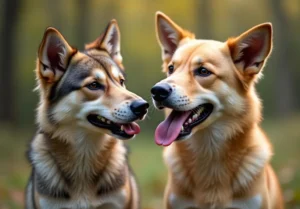Have you ever wondered why cats are smaller than dogs? It’s a common observation that these two popular pets come in different sizes, but have you ever stopped to think about why that is? Let’s explore the fascinating reasons behind this intriguing phenomenon.
Evolutionary Differences
Cats and dogs may have a common ancestor, but their evolutionary paths diverged, leading to their distinct sizes. Cats, as solitary hunters, evolved to be smaller and more agile to stalk and ambush their prey, requiring less energy to sustain their size. On the other hand, dogs, as pack animals, needed to be larger to take down larger prey and compete within their social structure. This difference in hunting techniques and social dynamics has influenced their sizes over time. Additionally, selective breeding by humans has further accentuated these size disparities, shaping cats and dogs according to our preferences and needs.
Genetic Factors
When it comes to determining the size of cats and dogs, genetics play a crucial role. Inheritance of specific genes can lead to variations in size within each species. For example, genes responsible for growth hormones can influence how large or small a cat or dog will ultimately become. Furthermore, breeds within each species may have specific genetic traits that affect their size, such as dachshunds being bred for their small stature. Understanding these genetic factors can provide insight into why cats tend to be smaller than dogs on a genetic level.
- Unique Insight: In addition to genetic factors, nutritional intake during development can also impact the size of cats and dogs. Providing appropriate nutrition during their growth stages is vital in ensuring they reach their optimal size. Balanced diets that cater to their species-specific needs can contribute to healthy growth and maintenance of size throughout their lives.
Dietary Needs
Cats have specific dietary requirements that differ from dogs. They are obligate carnivores, meaning they need animal-based protein to thrive. This high protein diet helps them maintain lean muscle mass and a small body size. On the other hand, dogs are more omnivorous, so they can digest a variety of foods, including plant-based sources of protein. This flexibility in their diet allows them to grow larger compared to cats.
In addition, cats require certain nutrients like taurine and arachidonic acid that are found primarily in animal tissues. These essential nutrients help keep cats healthy and play a crucial role in their overall growth and development. Due to these specific dietary needs, cats tend to have smaller body sizes compared to dogs.
Activity Levels
When looking at the size difference between cats and dogs, their activity levels play a significant role. Dogs are generally more active pets, requiring regular exercise and physical activity to stay healthy. This increased activity level can contribute to larger body sizes and more muscle mass in dogs compared to cats.
On the other hand, cats are known for their independent and less active nature. They tend to conserve energy and engage in short bursts of high-intensity activity. This lower overall activity level can lead to smaller body sizes in cats compared to dogs.
Unique Insight: While dogs require regular exercise to maintain their health and size, cats have evolved to be efficient hunters with bursts of energy. This natural behavior helps them conserve energy and maintain a smaller body size.
Breeding Practices
Breeding Practices: One significant factor influencing the size difference between cats and dogs lies in selective breeding. Over generations, humans have intentionally bred cats and dogs to exhibit specific traits, including size. While cats have been bred more for companionship and pest control, resulting in smaller sizes, dogs have been bred for various purposes like hunting, guarding, and herding, leading to a wider range of sizes. This intentional breeding by humans has played a crucial role in shaping the size differences we see today in cats and dogs.
Environmental Adaptations
Environmental Adaptations: Another key factor contributing to the size discrepancy between cats and dogs can be attributed to their historical environments. Cats, being solitary hunters, have adapted to thrive in smaller, more agile forms suited for stalking prey in narrow spaces. On the other hand, dogs, which often lived and worked in packs, have developed a wider range of sizes to fulfill different roles within the community. The environmental pressures faced by cats and dogs in the wild have influenced their size variances, with cats typically being smaller due to the demands of their hunting lifestyle.
Additional Unique Insight: In addition to selective breeding and environmental adaptations, it is essential to consider that cats and dogs have different growth rates. Cats generally reach their full size within the first year of life, while dogs can continue growing for up to two years, contributing to the size differences between the two species.
Interesting Fact: Cat Breeds
Did you know that the smallest cat breed is the Singapura, weighing in at just 4-8 pounds? On the other end of the spectrum, the Maine Coon holds the title for the largest domesticated cat breed, with males weighing up to 18 pounds or more. These fascinating differences in size among cat breeds showcase the incredible variety within the feline world. Each breed has its unique charm and characteristics that contribute to their distinct sizes.
Unique Characteristics
One key factor contributing to the size difference between cats and dogs is their evolutionary history. Cats are descended from solitary hunters, which favored agility and stealth over size. This is why cats are typically smaller and more nimble compared to dogs, who evolved from pack animals that needed size and strength for hunting and protection. Additionally, cats have a unique skeletal structure that allows for flexibility and swift movement, traits that are crucial for their hunting prowess.
List of unique characteristics contributing to size differences:
- Fast Metabolism: Cats have a higher metabolism than dogs, which helps them maintain their smaller size.
- Thinner Bones: Cats have thinner bones compared to dogs, contributing to their lightweight and agile nature.
- Muscle Composition: Cats have more fast-twitch muscle fibers, giving them quick bursts of energy for hunting and climbing.
- Flexible Spines: Cats have incredibly flexible spines, allowing them to twist and turn with ease during hunting activities.
- Smaller Stature: Cats are generally smaller in stature compared to most dog breeds, reflecting their solitary hunting origins.
Understanding these unique characteristics sheds light on why cats are typically smaller than dogs. Each trait plays a role in shaping the distinctive size differences between these beloved pets.
Myth Busting: Size Equates to Ferocity
Forget the misconception that larger animals are always more aggressive or dominant than smaller ones. While dogs may generally be larger than cats, size doesn’t determine ferocity. In reality, a cat’s small size can be an advantage, allowing them to be quick, agile, and able to escape potentially dangerous situations easily. Cats’ territorial nature and independent behavior may give the impression of aggression, but it’s more about self-preservation than dominance. So, don’t judge a pet by its size – it’s not always the bigger, the bolder!
Fun Fact: Smallest Cats and Dogs
Did you know that the world’s smallest cat breed is the Singapura? These pint-sized felines typically weigh around 4-6 pounds, proving that good things come in small packages! On the other hand, the title of the smallest dog breed goes to the Chihuahua. These tiny pups usually weigh in at a mere 2-6 pounds, making them incredibly lovable and portable companions. Despite their diminutive size, both these tiny pets pack a whole lot of personality and charm. Small but mighty, indeed!
Extra Tip: When opting for a pet, remember that size isn’t the only factor to consider. Whether you choose a larger dog or a smaller cat, it’s essential to find a pet that fits your lifestyle, personality, and needs. The most important thing is the love and companionship they bring into your life, regardless of their size.
Human Influence
Human interactions and preferences have played a significant role in the size difference between cats and dogs. Over centuries, cats were selectively bred for companionship and pest control, leading to their smaller size compared to dogs. Cats were valued for their ability to hunt mice and protect food stores from vermin, while dogs were often bred for specific tasks like hunting, herding, or guarding.
One unique insight into human influence on the size disparity is the impact of urbanization. As more people moved into cities, smaller living spaces became more common, leading to a preference for smaller pets like cats. This shift in living environments further reinforced the trend of cats being smaller than dogs.
In modern times, the popularity of small dog breeds as fashion accessories or “lap dogs” has continued to influence their size. People often choose smaller dogs for their portability and ease of care, contributing to the perpetuation of size differences between cats and dogs. So, human preferences and lifestyle choices have played a crucial role in shaping the sizes of these beloved pets.
Alex, a passionate animal lover, has experience in training and understanding animal behavior. As a proud pet parent to two dogs and three cats, he founded AnimalReport.net to share insights from animal experts and expand his knowledge of the animal kingdom.




